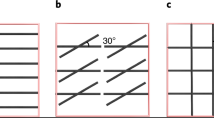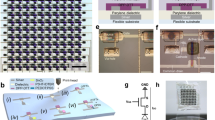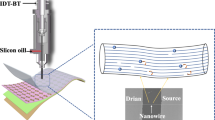Abstract
The development of optically transparent and mechanically flexible electronic circuitry is an essential step in the effort to develop next-generation display technologies, including ‘see-through’ and conformable products. Nanowire transistors (NWTs) are of particular interest for future display devices because of their high carrier mobilities compared with bulk or thin-film transistors made from the same materials, the prospect of processing at low temperatures compatible with plastic substrates, as well as their optical transparency and inherent mechanical flexibility. Here we report fully transparent In2O3 and ZnO NWTs fabricated on both glass and flexible plastic substrates, exhibiting high-performance n-type transistor characteristics with ∼82% optical transparency. These NWTs should be attractive as pixel-switching and driving transistors in active-matrix organic light-emitting diode (AMOLED) displays. The transparency of the entire pixel area should significantly enhance aperture ratio efficiency in active-matrix arrays and thus substantially decrease power consumption.
This is a preview of subscription content, access via your institution
Access options
Subscribe to this journal
Receive 12 print issues and online access
$259.00 per year
only $21.58 per issue
Buy this article
- Purchase on Springer Link
- Instant access to full article PDF
Prices may be subject to local taxes which are calculated during checkout





Similar content being viewed by others
References
Snell, A. J., Mackenzie, K. D., Spear, W. E., LeComber, P. G. & Hughes, A. J. Application of amorphous silicon field effect transistors in addressable liquid crystal display panels. Appl. Phys. Lett. 24, 357–362 (1981).
Madelung, O. (ed.) Technology and Applications of Amorphous Silicon (Springer, Berlin, 2000).
Ucjikoga, S. Low-temperature polycrystalline silicon thin-film transistor technologies for system-onglass displays. MRS Bull. 27, 881–886 (2002).
Carcia, P. F., McLean, R. S., Reilly, M. H. & Nunes, G. Transparent ZnO thin-film transistor fabricated by rf magnetron sputtering. Appl. Phys. Lett. 82, 1117–1119 (2003).
Fortunato, E. et al. Recent advances in ZnO transparent thin film transistors. Thin Solid Films 487, 205–211 (2005).
Hoffman, R. L., Norris, B. J. & Wager, J. F. ZnO-based transparent thin-film transistors. Appl. Phys. Lett. 82, 733–735 (2003).
Nomura, K. et al. Thin-film transistor fabricated in single-crystalline transparent oxide semiconductor. Science 300, 1269–1272 (2003).
Presley, R. E. et al. Tin oxide transparent thin-film transistors. J. Phys. D. 37, 2810–2813 (2004).
Wang, L. et al. High performance all transparent inorganic–organic hybrid thin-film transistors. Nature Mater. 5, 893–900 (2006).
Hur, S.-H. Park, O. & Rogers, J.A. Extreme bendability of single-walled carbon nanotube networks transferred from high-temperature growth substrates to plastic and their use in thin-film transistors. Appl. Phys. Lett. 86, 243502 (2005).
Takenobu, T. et al. High-performance transparent flexible transistors using carbon nanotube films. Appl. Phy. Lett. 88, 33511 (2006).
Minami, T., Yamamoto, T., Toda, Y. & Miyata, T. Transparent conducting zinc-co-doped ITO films prepared by magnetron sputtering. Thin Solid Films 373, 189–194 (2000).
Yaglioglu, B., Yeom, H.-Y. & Paine, D. C. Crystallization of amorphous In2O3-10 wt% ZnO thin films annealed in air. Appl. Phy. Lett. 86, 261908 (2005).
Fortunato, E. et al. High mobility amorphous/nanocrystalline indium zinc oxide deposited at room temperature. Thin Solid Films 502, 104–107 (2006).
Xiang, J. et al. Ge/Si nanowire heterostructures as high-performance field-effect transistors. Nature 441, 489–493 (2006).
Cui, Y., Zhong, Z., Wang, D., Wang, W. U. & Lieber, C. M. High performance silicon nanowire field effect transistors. Nano Lett. 3, 149–152 (2003).
Cha, S. N. et al. High performance ZnO nanowire field effect transistor. Proc. ESSDERC 217–220 (2005).
Kim, W. et al. Germanium nanowire field-effect transistors with SiO2 and high-κ HfO2 gate dielectrics. Appl. Phys. Lett. 87, 173101 (2005).
Weiher, R. L. Electrical properties of single crystals of indium oxide. J. Appl. Phys. 33, 2834–2839 (1962).
Li, Y., Meng, G. W., Zhang, L. D. & Phillipp, F. Ordered semiconductor ZnO nanowire arrays and their photoluminescence properties. Appl. Phys. Lett. 76, 2011–2013 (2000).
Yao, B. D., Chan, Y. F. & Wang, N. Formation of ZnO nanostructures by a simple way of thermal evaporation. Appl. Phys. Lett. 81, 757–759 (2002).
Banerjee, D. et al. Large-quantity free-standing ZnO nanowires. Appl. Phys. Lett. 83, 2061–2063 (2003).
Pan, Z. W., Dai, Z. R. & Wang, Z. L. Nanobelts of semiconducting oxides. Science 291, 1947–1949 (2001).
Wan, Q., Yu, K., Wang, T. H. & Lin, C. L. Low-field electron emission from tetrapod-like ZnO nanostructures synthesized by rapid evaporation. Appl. Phys. Lett. 83, 2253–2255 (2003).
Ju, S., Janes, D. B., Lu, G., Facchetti, A. & Marks, T. J. Effects of bias stress on ZnO nanowire field-effect transistors fabricated with organic gate nanodielectrics. Appl. Phys. Lett. 89, 193506 (2006).
Li, C. et al. Diameter-controlled growth of single-crystalline In2O3 nanowires and their electronic properties. Adv. Mater. 15, 143–145 (2003).
Banerjee, D. et al. Synthesis and photoluminescence studies on ZnO nanowires. Nanotechnology 15, 404–409 (2004).
Lin, H. C., Ye, P. D. & Wilk, G. D. Leakage current and breakdown electric-field studies on ultrathin atomic-layer-deposited Al2O3 on GaAs. Appl. Phys. Lett. 87, 182904 (2005).
Lang, O. et al. Thin film growth and band lineup of In2O3 on the layered semiconductor InSe. J. Appl. Phys. 86, 5687–5691 (1999).
Gassenbauer, Y. et al. Surface states, surface potentials, and segregation at surfaces of tin-doped In2O3 . Phys. Rev. B 73, 245312 (2006).
Goldberger, J., Sirbuly, D., Law, M. & Yang, P. ZnO nanowire transistors. J. Phys. Chem. B 109, 9–14 (2005).
Martins, R. et al. Zinc oxide as an ozone sensor. J. Appl. Phys. 96, 1398–1408 (2004).
Jiang, X., Wong, F. L., Fung, M. K. & Lee, S. T. Aluminum-doped zinc oxide films as transparent conductive electrode for organic light-emitting devices. Appl. Phys. Lett. 83, 1875–1877 (2003).
Kim, S. Y., Lee, J.-L., Kim, K.-B. & Tak, Y.-H. Effect of ultraviolet-ozone treatment of indium-tin-oxide on electrical properties of organic light emitting diodes. J. Appl. Phys. 95, 2560–2563 (2004).
Liu, F. et al. One-dimensional transport of In2O3 nanowires. Appl. Phys. Lett. 86, 213101 (2005).
Chang, P.-C. et al. High-performance ZnO nanowire field effect transistors. Appl. Phys. Lett. 89, 133113 (2006).
Zhang, D. et al. Electronic transport studies of single-crystalline In2O3 nanowires. Appl. Phys. Lett. 82, 112–114 (2003).
Cha, S. N. et al. High-performance ZnO nanowire field effect transistor using self-aligned nanogap gate electrodes. Appl. Phys. Lett. 89, 263102 (2006).
Moon, T.-H. et al. Chemical surface passivation of HfO2 films in a ZnO nanowire transistor. Nanotechnology 17, 2116–2121 (2006).
Ju, S. et al. Low operating voltage single ZnO nanowire field-effect transistors enabled by self-assembled organic gate nanodielectrics. Nano Lett. 5, 2281–2286 (2005).
Ju, S. H. et al. High performance 2.2″ QCIF full color AMOLED displays based on electrophosphorescence. SID 02 DIGEST 37.3, 1096–1099 (2002).
Rao, S., Huang, L., Setyawan, W. & Hong, S. Nanotube electronics: Large-scale assembly of carbon nanotubes. Nature 425, 36–37 (2003).
Wu, Y., Xiang, J., Yang, C., Lu, W. & Lieber, C. M. Single-crystal metallic nanowires and metal/semiconductor nanowire heterostructures. Nature 430, 61–65 (2004).
Joseph, V. R. et al. Electronic connection to the interior of a mesoporous insulator with nanowires of crystalline RuO2 . Nature 406, 169–172 (2000).
Huang, Y., Duan, X., Wei, Q. & Lieber, C. M. Directed assembly of one-dimensional nanostructures into functional networks. Science 291, 630–633 (2001).
Kuykendall, T. et al. Crystallographic alignment of high-density gallium nitride nanowire arrays. Nature Mater. 3, 524–528 (2004).
Duan, X. et al. High-performance thin-film transistors using semiconductor nanowires and nanoribbons. Nature 425, 274–278 (2003).
Menard, E., Lee, K. J., Khang, D. Y., Nuzzo, R. G. & Rogers, J. A. A printable form of silicon for high performance thin film transistors on plastic substrates. Appl. Phys. Lett. 84, 5398–5400 (2004).
Ju, S. et al. n-Type field-effect transistors using multiple Mg-doped ZnO nanorods. IEEE Trans. Nanotech. (in the press).
Wang, D. et al. Germanium nanowire field-effect transistors with SiO2 and high-κ HfO2 gate dielectrics. Appl. Phys. Lett. 83, 2432–2434 (2003).
Vashaee, D. et al. Electrostatics of nanowire transistors with triangular cross sections. J. Appl. Phys. 99, 54310 (2006).
Acknowledgements
We thank Samsung SDI for providing substrate materials and measuring the ITO work function. This work was supported in part by the NASA Institute for Nanoelectronics and Computing under grant NCC-2-1363 and the Northwestern University MRSEC under grant DMR-0520513.
Author information
Authors and Affiliations
Contributions
All authors contributed equally to this work and all discussed the results and commented on the manuscript.
Corresponding authors
Ethics declarations
Competing interests
The authors declare no competing financial interests.
Rights and permissions
About this article
Cite this article
Ju, S., Facchetti, A., Xuan, Y. et al. Fabrication of fully transparent nanowire transistors for transparent and flexible electronics. Nature Nanotech 2, 378–384 (2007). https://doi.org/10.1038/nnano.2007.151
Received:
Accepted:
Published:
Issue Date:
DOI: https://doi.org/10.1038/nnano.2007.151
This article is cited by
-
Structural, optical, and magnetic properties of Gd-doped In2O3 nanocrystalline powder
Indian Journal of Physics (2024)
-
Nanowire implosion under laser amplified spontaneous emission pedestal irradiation
Scientific Reports (2023)
-
Al2O3/HfO2 Nanolaminate Dielectric Boosting IGZO-Based Flexible Thin-Film Transistors
Nano-Micro Letters (2022)
-
Bottom-up fabrication of n-ZnO-based memristor and p-Cu2O/n-ZnO heterojunction diode using electroless deposition
Journal of Materials Science: Materials in Electronics (2022)
-
High elasticity of CsPbBr3 perovskite nanowires for flexible electronics
Nano Research (2021)



